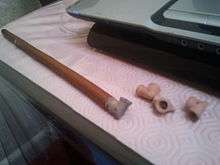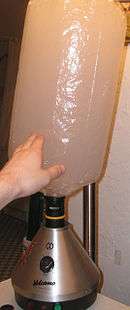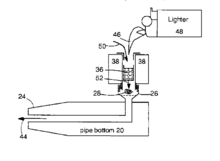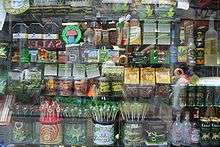Cannabis consumption
Among the variety of ways cannabis is consumed, forms of smoking or oral consumption are most common. Each method leads to subtly different psychoactive effects due to the THC and other chemicals being activated, and then consumed through different administration routes. It is generally considered that smoking, which includes combustion toxins, produces a somewhat more relaxing ("stoned") effect, while eating delays the onset of effect but the duration of effect is typically longer.[1] In a 2007 ScienceDaily report of research conducted at University of California–San Francisco, researchers reported that vaporizer users experience the same biological effect, but without the toxins associated with smoking.[2]

Smoking
Cannabis can be smoked with implements such as bongs, hookahs, and pipes. Makeshift pipes or commercial pipes may be used, or cigarette-like joint or cigar-like blunt may be smoked.
Local methods have differed by the preparation of the cannabis plant before use, the parts of the cannabis plant that are used, and the treatment of the smoke before inhalation. In early times, as in some parts of Africa today, a pile of cannabis was simply laid on a fire and the smoke inhaled.[3]
Vaporization


28. Insert cannabis, other herbs or essential oils here
36. Flame filter prevents flame from igniting herb which instead is heated to vaporization temperature.
A vaporizer heats herbal cannabis to 157–210 °C (315–410 °F), which causes the active ingredients to evaporate into a gas without burning any plant material (the boiling point of THC is 157 °C (315 °F).[4][5] Vaporizing releases a lower proportion of carbon monoxide and other toxic chemicals than does smoking, although the proportion may vary depending on the design of the vaporizer and the temperature at which it is set. A MAPS-NORML study using a Volcano vaporizer reported 95% THC and no toxins delivered in the vapor.[6] An older study using less sophisticated vaporizers found some toxins.[7]
A pocket-sized form of vaporizer is available as of September 2013—one particular model uses a rechargeable battery, is constructed from wood, and features a removable cover.[8] Typically, portable vaporizers can only be used for liquids, feature pre-soaked wicks, and require the user to operate a cartridge.
Oral consumption

As an alternative to smoking, cannabis may be consumed orally. However, herbal cannabis must be sufficiently heated or dehydrated to cause decarboxylation of its most abundant cannabinoid, tetrahydrocannabinolic acid, into psychoactive THC.[9]
Food

Although hashish is sometimes eaten raw or mixed with boiling water, THC and other cannabinoids are more efficiently absorbed into the bloodstream when combined with butter and other lipids or, less so, dissolved in ethanol. The time to onset of effects depends strongly on stomach content, but is usually 1 to 2 hours, and may continue for a considerable length of time, whereas the effects of smoking or vaporizing cannabis are almost immediate, lasting a shorter length of time.[10]
All of the active constituents enter the body when cannabis is consumed orally. It has been shown that the primary active component of cannabis, Δ9-THC, is converted to the more psychoactive 11-hydroxy-THC by the liver.[11] Titration to the desired effect by ingestion is more difficult than through inhalation, due to the long onset time for the effects.
Drink
Cannabis material can be leached in high-proof spirits (often grain alcohol) to create a “Green Dragon”. This process is often employed to make use of low-potency stems and leaves.
Cannabis can also be consumed as a cannabis tea. Although THC is lipophilic and only slightly water soluble (with a solubility of 2.8 mg per liter),[12] enough THC can be dissolved to make a mildly psychoactive tea. However, water-based infusions are generally considered to be an inefficient use of the herb.[13] However, bhang, a decoction of cannabis and spices in milk, averts the issue, as milk contains the fat in which the THC is soluble.
Fungi
To kill potentially very dangerous aspergillus, and other microorganisms, researchers Levitz and Diamond (1991) suggested baking marijuana in home ovens at 150 °C (302 °F) for five minutes before smoking. Oven treatment killed conidia of A. fumigatus, A. flavus, but did not degrade the THC." However, neither this, nor other suggested sterilization methods, degrade microbial antigens or decompose the microbial toxins. Many cannabinoids evaporate below 150 °C (302 °F); in particular, the more volatile aromatic oils and terpenes, which give cannabis its distinctive flavors and odors.[14]
See also
References
- ↑ "Wellness Center - Marijuana". American University. American University. 2013. Retrieved 2 December 2013.
- ↑ "Marijuana Vaporizer Provides Same Level Of THC, Fewer Toxins, Study Shows". ScienceDaily. ScienceDaily®. 16 May 2007. Retrieved 2 December 2013.
- ↑ "Cannabis Vault : Spiritual Use #2". erowid.org.
- ↑ "Cannabis and Cannabis Extracts: Greater Than the Sum of Their Parts?" (PDF). haworthpress.com. Retrieved 2011-01-25.
- ↑ 1989. The Merck Index, 11th ed., Merck & Co., Rahway, New Jersey
- ↑ Gieringer, Dale H.; Joseph St. Laurent; Scott Goodrich (2004). "Cannabis Vaporizer Combines Efficient Delivery of THC with Effective Suppression of Pyrolytic Compounds" (PDF). Journal of Cannabis Therapeutics. 4 (1): 7–27. doi:10.1300/J175v04n01_02. Retrieved 2006-04-21.
- ↑ Gieringer, Dale. "Marijuana Water Pipe and Vaporizer Study". Retrieved 2006-04-21.
- ↑ Jeff Winkler (13 September 2013). "Stealth stoner". Aeon Magazine. Aeon Magazine Ltd. Retrieved 14 September 2013.
- ↑ "Does marijuana have to be heated to become psychoactive?". Cannabisculture.com. 2003-01-02. Retrieved 2011-02-23.
- ↑ "Erowid Cannabis (Marijuana) Vault : Effects". Retrieved 28 April 2012.
- ↑ Paulo Borini; Romeu Cardoso Guimarães; Sabrina Bicalho Borini (May 2004). "Possible hepatotoxicity of chronic marijuana usage". Sao Paulo Medical Journal. 122 (3): 120–3. doi:10.1590/S1516-31802004000300007. PMID 15448809. Retrieved 2006-05-02.
- ↑ Cannabis consumption in the ChemIDplus database
- ↑ Leslie Iversen (2003-04-08). "Cannabis and the brain. Invited review Brain". Brain. Brain – Oxford Journals. 126 (6): 1252–1270. doi:10.1093/brain/awg143. Retrieved 2011-02-23.
- ↑ "Microbiological contaminants of marijuana". hempfood.com. Retrieved 2008-06-22.

